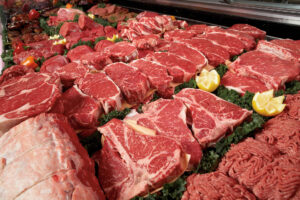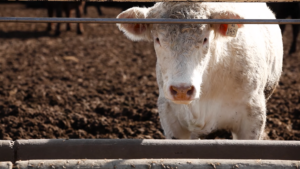Le bœuf au-delà des frontières🎙️
CLIQUEZ SUR LE BOUTON « PLAY » POUR ÉCOUTER CET ÉPISODE (article offert en anglais seulement):
Écoutez d’autres épisodes sur BeefResearch.ca, Spotify, Apple Podcasts, Amazon Music ou Podbean.
Cet article rédigé par le Dr Reynold Bergen, directeur scientifique du BCRC, a été initialement publié dans le numéro d’octobre 2024 du magazine Canadian Cattlemen et est reproduit sur BeefResearch.ca avec la permission de l’éditeur.
L’industrie canadienne du bœuf repose sur les exportations. En 2024, le Canada a exporté 550 000 tonnes métriques de bovins vivants et de bœuf (net des importations). La plupart des exportations canadiennes (75 % du volume et 79 % de la valeur) étaient destinées aux États-Unis, car ce pays est notre voisin immédiat, nos produits sont similaires et les consommateurs américains et canadiens ont des préférences et des attentes comparables en matière de qualité.
Le Japon était le deuxième plus grand marché d’exportation du Canada (9 % en volume et 7 % en valeur). Le Japon achète principalement du Canada du bout de poitrine, du flanc/de la poitrine, de la palette et des côtes. La coupe primaire « côtes » comprend le faux-filet, qui est une des coupes les plus persillées et de la plus haute qualité. Mais « très persillé » et « de haute qualité » sont des notions subjectives ! Quiconque a déjà vu ou goûté du bœuf Wagyu japonais sait qu’il est beaucoup plus persillé que le bœuf canadien.

La différence de persillage entre le bœuf canadien et japonais est en partie due à la génétique. Les bovins japonais de race Black élevés pour le bœuf Wagyu au Japon présentent un persillage plus important que les races bovines traditionnellement utilisées au Canada. Elle est également due en partie à la gestion (les bovins japonais de race Black sont nourris différemment et pendant beaucoup plus longtemps que les bovins canadiens). Mais la différence de persillage entre le bœuf japonais et canadien est également due en partie aux différences entre les systèmes de classement.
Le système de classement canadien évalue le persillage dans le muscle du faux-filet entre les 12e et 13e côtes (à peu près à mi-chemin entre les pattes avant et arrière) et attribue une note A, AA, AAA ou Canada Primé. Le système de classement japonais évalue le persillage dans les muscles situés entre la 6e et la 7e côte (derrière l’épaule) et attribue l’une des 12 notes (JMGA 1 à JMGA 12). Le muscle du faux-filet est de forme conique et devient beaucoup plus petit à mesure que l’on passe du site de classement canadien au site de classement japonais. Cela signifie que les veines de gras intramusculaire (marbrure) qui traversent le faux-filet dans le sens de la longueur sont beaucoup plus concentrées et visibles sur le site japonais. Par conséquent, le muscle du faux-filet provenant de la même carcasse aura un score de persillage plus élevé sur le site de classement japonais que sur le site de classement canadien, indépendamment de sa génétique ou de son alimentation. La possibilité de « convertir » la note de marbrure canadienne en note de marbrure japonaise pourrait contribuer à commercialiser plus efficacement le bœuf canadien au Japon.
Oscar Lopez-Campos a dirigé une équipe au Centre de recherche et de développement de Lacombe d’Agriculture et Agroalimentaire Canada (AAC Lacombe) qui examinait si l’indice de persillage au site de classement canadien permet de prédire l’indice de persillage au site de classement japonais (Relating the Canadian and Japanese Beef Grading Sites)(https://doi.org/10.1016/j.meatsci.2025.109832).
Ce qu’ils ont fait
Ils ont élevé 634 veaux croisés Angus et les ont abattus comme veaux finis jeunes (âgés de 11 à 13 mois) (calf-fed) ou comme bouvillons finis d’un an (yearling-fed) (âgés de 15 à 17 mois) à l’AAC Lacombe. Ces carcasses faisaient partie d’une étude beaucoup plus vaste qui sera présentée dans un prochain numéro. Les 394 carcasses présentant le plus haut degré de persillage (92,5 % étaient de catégorie AAA ou Primé) ont été utilisées pour comparer divers paramètres de qualité de la viande, tels que le pH, les mesures de couleur, le pourcentage de gras intramusculaire et les notes visuelles de persillage, sur le site de classement canadien par rapport au site de classement japonais.
Ce qu’ils ont appris
En moyenne, le muscle du faux-filet contenait 33 % plus de gras intramusculaire sur le site de classement japonais que sur le site de classement canadien. Le site de classement japonais présentait également un pH plus élevé et une couleur rouge plus vive. Ces facteurs peuvent rendre les marbrures plus visibles à l’œil du classificateur. Ensemble, la quantité plus importante de gras intramusculaire et la couleur plus rouge de la viande ont donné des notes de marbrure plus élevées sur le site de classement japonais que sur le site de classement canadien.
Près de 90 % des carcasses classées AAA sur le site canadien entre la 12e et la 13e côte auraient été classées JMGA 3 ou JMGA 4 sur le site japonais entre la 6e et la 7e côte, et plus de 85 % des carcasses classées Canada Primé auraient été classées JMGA 4 ou JMGA 5. Mais il convient également de noter que près d’un quart (22 %) des carcasses étudiées ont obtenu une note comprise entre JMGA 6 et JMGA 10 sur le site japonais de classement. Cela les place près du sommet du système japonais à 12 catégories. Ces carcasses canadiennes peuvent également présenter une musculature bien meilleure que la conformation plus « laitière » des bovins japonais Black traditionnels.
Qu’est-ce que cela signifie pour vous ?
Bien que le Japon soit un marché relativement petit pour le bœuf canadien, il est important et lucratif, notamment parce qu’il contribue à diversifier nos marchés au-delà du Canada et des États-Unis. Le Canada ne produit que 2 % du bœuf mondial. En tant que petit acteur sur un vaste marché international, le Canada doit être en mesure d’identifier les marchés qui recherchent ce que nous produisons et de leur donner des raisons d’acheter nos produits.

Conclusion
Le bœuf Wagyu haut de gamme est inabordable pour la plupart des consommateurs japonais. Mais les bovins canadiens peuvent produire une viande acceptable pour le consommateur japonais moyen. Le fait de pouvoir indiquer comment les grades de qualité canadiens correspondent aux scores japonais en matière de persillage pourrait aider notre bœuf à se démarquer légèrement sur un marché d’exportation très important.
Le Beef Cattle Research Council est une organisation industrielle à but non lucratif financée par le Prélèvement national sur les bovins de boucherie. Le BCRC s’associe à Agriculture et Agroalimentaire Canada, aux groupes provinciaux de l’industrie bovine et aux gouvernements afin de faire progresser le transfert de la recherche et de la technologie à l’appui de la vision de l’Industrie canadienne du bœuf, qui est d’être reconnue comme un fournisseur privilégié de bœuf, de bovins et de génétique sains et de haute qualité. Apprenez-en davantage sur le BCRC sur le site www.beefresearch.ca.
Le partage ou la réimpression des publications du BCRC sont les bienvenus et sont encouragés. Veuillez mentionner le Beef Cattle Research Council, fournir l’adresse du site Web, www.BeefResearch.ca, et nous faire savoir que vous avez choisi de partager l’article en nous envoyant un courriel à [email protected].
Vos questions, commentaires et suggestions sont les bienvenus. Contactez-nous directement ou lancez une discussion publique en publiant vos idées ci-dessous.